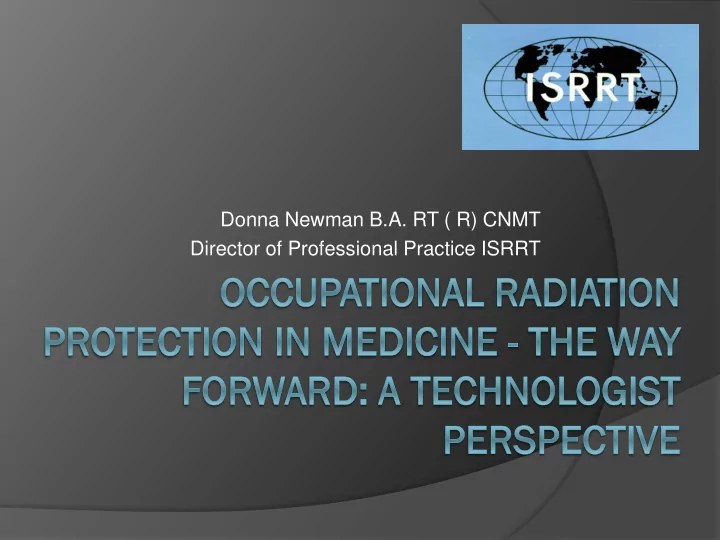

Donna Newman B.A. RT ( R) CNMT Director of Professional Practice ISRRT
Responsibilities Worker (BSS 3.83) Workers shall: follow any applicable rules for protection use properly the monitoring devices and the protective equipment and clothing provided co-operate with the licensee with respect to protection Factors affecting technologist exposure( Occupational Dose Exposure ) How use x-ray system Whether protective measures used Optimization of patient dose Number of procedure performed Height of technologist New Multi Modality( Hybrid Imaging ) PET/CT, SPECT/CT, PET/MRI IAEA-13.1: Occupational exposure - Regulatory aspec
Occupat ational ional Radiation ation protection ection is a shared red respon sponsib sibilit ility: y: Imagi ging ng Team( m( Radiologist iologist, , Medical al Physicist, sicist, Radiologic iologic Technologist nologist ) What is the Technologi ologist st Role le? ICRP 2008 Recommendations ○ Justification, Dose Limitations ,Optimization of protection Optimize Operating parameter of you Imaging System – Quality Assurance Program and Quality Control Program Use recommended International guidelines that are available to assist in optimization of image quality and radiation dose Become familiar with Professional Organization’s and website’s that are internationally accepted for best practice for dose reduction Ensure Qualifications of Staff Initial and yearly Competency check list Radiation Protection guidelines in line with new scientific knowledge ( Hybrid Imaging- PET/CT, PET/MRI, SPECT/CT) ALARA=Time ,Distance and Shield
Technologist Protection: By Modality Diagnostic Radiology Control Booth ,Exposure button /connected to a cord, Lead glass, X-ray tube always pointing to the receptor/ SFOV for beam collimation Portable machine- 6 ft cord, lead apron ( 6 Ft and at 90 degree angle) Properly position patient reduce non targeted tissue and use tight collimation Effective Immobilization strategies young patients( age 5 under) more effective then manual physical restraints by staff, to avoid motion Shielding- Eye protection, Face protection, Thyroid protection, Hand protection
Technologist Protection: By Modality CT Nuclear Medicine/PET • Adjust CT doses to patient Protective clothing/Use size, Beam Ma Modulation Syringe Shields, lab coat • Automatic dose reduction and gloves, absorbent pad methods in CT scanners with • Contamination monitor optimal x-ray tube voltage Shields-Bench top • Standardize CT protocols; periodic review shield,Vial shields,Syringe • Ct Collimation to reduce shield scatter • forceps, tongs • Pitch • Develop CT QC programs Post processing and real time Special consideration for noise reduction algorithms for I-131 Therapy DR, CT and Fluoro
3 Principles of Radiation Protection: Time, Distance and Shielding Applications Fluoro and C-arm ( Diagnostic, Interventional , OR Minimize Fluoro Time: last hold, tap instead of continuous Position patient /as far from x-ray tube tight collimation Protocol’s with x -ray tube opposite the operator Personal protective gear/ lead apron, Thyroid shield, lead eye wear Equipment shielding/ Ceiling shields, table shield, patient shielded tarps, Wear personal Dosimeter/ Use lowest Dose possible
Lessons Learned : Radiation – associated Cataracts Two separate studies in 2010 Studied Cataracts in Interventional procedure and concluded: “Without proper eye protection health care professionals were at higher risk of developing cataract” 2011(ICRP) Based this data 2011 the international commission on Radiological protection (ICRP) reduced the lens threshold value of absorbed dose for cataract form” 3.0 Gy to .50 Gy ” Radiation cataract risk in interventional cardiology personnel, radiation Res.,Vano e. 2010:174(4):490-495 Risk for radiation – induced cataract for staff in interventional cardiology: Is there a reason for concern?, Ciraj-Bjelac O, Catheter Cardiovasc Interv. 2010:76(6):826-834
Conclusion: Team eam app pproach(Radiologis oach(Radiologist, t, Physi sicist cist and d Tech echnolog nologist) ist) Better QA and QC standardization needed in all countries Close the gap the exist in radiation protection programs world wide Ensure that all workers have access to radiation protection devices ( aprons, thyroid shield, lead eye wear) Non- traditional educational material available on the newest hybrid equipment ( PET/CT, PET/MRI, SPECT/CT ect. ) best practice information
Recommend
More recommend